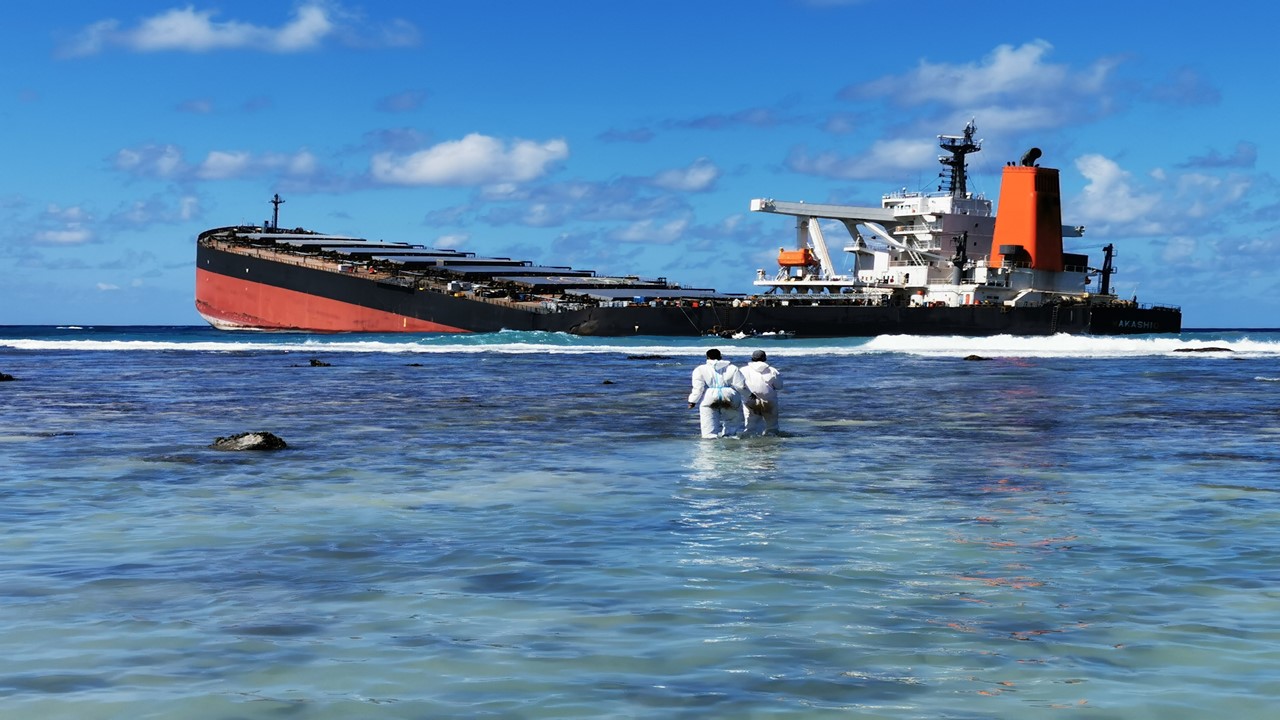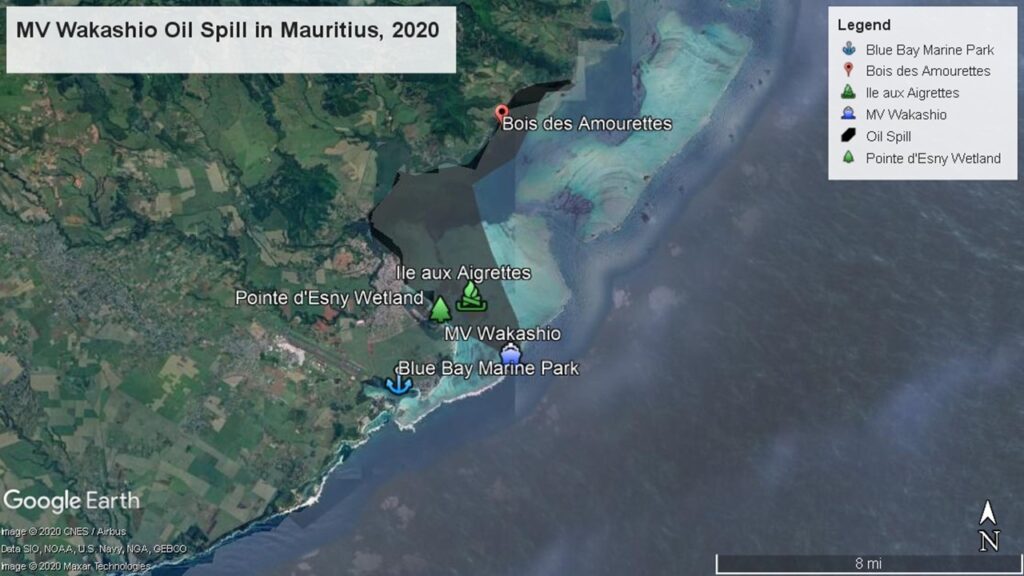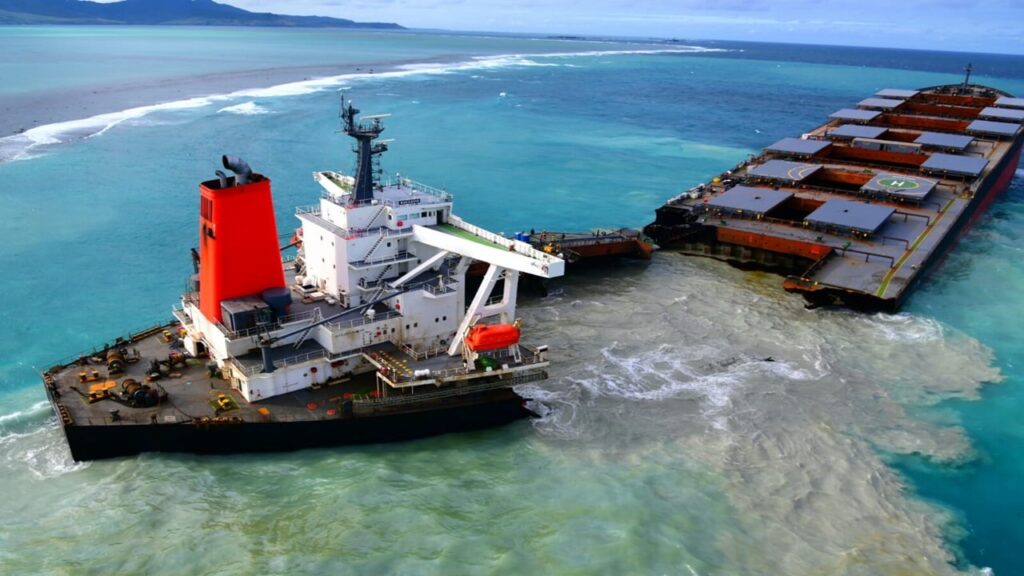Mauritius Oil Spill: Japanese MV Wakashio wrecks on reef

The 2020 Mauritius oil spill is a nightmare that the citizens will remember for years to come.
Mauritius star and key of the Indian Ocean and shipping routes
The Indian Ocean is one of the busiest shipping lanes in the world. Broadly speaking, about 80% of all international trade in goods takes place by the sea. The UNCTAD reports that the port of Mauritius, Port Louis, is the most connected port in Eastern Africa.
Mauritius is famously known as the ‘star and key of the Indian Ocean’ because of its strategic geographic position. Back in the 1800s, most European ships navigated through the Cape of Good Hope on their way to India. Port Louis was thus an excellent port of call until Canal Suez opened in 1869.
Today, more than 2,000 ships cross the Mauritius Exclusive Economic Zone (EEZ) per month. They generally sail by some 12 nautical miles (22 km) off the coast. Given the nature of their voyage, they can stop at Port Louis or translate in a north-west or south-east direction.
Owners of the MV Wakashio
The Japanese Merchant Vessel (MV) Wakashio grounded on coral reefs in the south-east of Mauritius Island on July 25 2020. Basically, MV Wakashio (IMO: 9337119) was a 300 m bulk carrier designed to carry iron ore. Okiyo Maritime Corporation, which is an associate of Nagashiki Shipping Company Ltd, owned the ship while Mitsui O.S.K. Lines chartered the vessel.
Trajectory of MV Wakashio when it grounded in Mauritius
MV Wakashio left Lianyungang, China on July 04 July 2020 and was supposed to reach Tubarao, Brazil on August 13 2020. Despite its Japanese ownership, the ship was registered in Panama at that moment. A crew of 20 Filipino sailors was onboard although it was not carrying any cargo. Nevertheless, it contained 3,894 tons of fuel oil, 207 tons of diesel and 90 tons of lubricants.
It appears that Wakashio deviated from the common shipping lane by 55 nautical miles (102 km). In this way, it headed directly to the coral reef at Pointe d’Esny. Many ships have wrecked in the past in the south-east of Mauritius because of the barrier reefs that extend there. Maritime data shows that the ship tried a minor turn after crossing into the territorial waters of Mauritius. But it was in vain. Wakashio stuck to the coral reef.
Mauritius government actions to prevent an oil spill
The next day, July 26 2020, the government activated its National Oil Spill Contingency Plan. Though oil had not leaked out yet, authorities initiated the required preventive measures. They deployed oil booms around the ship to prevent potential oil pollution. The crew members landed and were quarantined according to COVID-19 policies.
Mauritius 1990 National Oil Spill Contingency Plan
The Mauritius National Oil Spill Contingency Plan dates to 1990. The International Maritime Organization (IMO) and the UNEP assisted in developing it. At that point in time, there was no oil refinery nor drilling in and near Mauritius (still). Oil tankers from the Middle East to the West did not pose a threat of oil spill as such [3]. The main sources of oil pollution were accidental spills and oily discharges during tank washing.
Mauritius received funds and materials to manage oil spills
Between 1998 to 2003, Mauritius benefitted from the Western Indian Ocean Island Oil Spill Contingency Planning Project [4]. The World Bank funded the project and the oil spill plan was updated. Moreover, Mauritius received essential materials like booms, dispersant and absorbents as well as training. Part V, Spill and environmental emergency, of the Environment Protection Act 2002, amended in 2008, concurrently made legal provision for oil spill management.
Training of stakeholders in Mauritius in oil spill management
Further to that, the Marine Highway Development and Prevention Project between 2008 to 2012 reinforced the oil spill plan. It included the setting up of a Regional Oil Spill response centre in Mauritius. There was additional training in oil spill management. Furthermore, professionals at the United Nations University in Malta trained two lawyers in maritime law and conventions.
Mauritius signed around 30 IMO conventions
In the same vein, authorities conducted several large-scale and local oil spill exercises and drills in the past. To date, Mauritius is a signatory to around 30 International Maritime Organization (IMO) conventions. This includes the International Convention for the Prevention of Pollution from Ships (MARPOL). What’s more, Mauritius is also a beneficiary of the MASE project of the European Union. Under this scheme, stakeholders develop maritime security structures for the region.
More recently in March 2020, government officials attended a UNEP Workshop in Zanzibar. The theme was on ‘Cooperation in preparedness and response to marine pollution incidents’.
Problems during the Mauritius Oil Spill
Unfortunately, in Mauritius, like in many other countries, legal authority on many environmental problems exists in Acts. But the primary aim was not to protect the environment. Likewise, though there is the required equipment, it requires frequent checks and testing to stay in working conditions. In addition to that, there is a frequent reshuffling of individual members within the respected authorities. Consequently, trained personnel are not where they should be.
Response to keep Wakashio afloat and pump out oil
By July 28 2020, the authorities assigned Smit Salvage to work with the local logistics group CELERO. They were to keep Wakashio afloat and pump out the over 4,000 tons of oil. One of four tugboats arrived three days later and was ready to start the operation. But the weather conditions were unfavourable and the operation halted.
Wakashio spills out oil into the sea
Throughout the coming days, concern and fear mounted in the population given the particular position of the ship. Local fishermen urged the authorities to effectuate the pumping. On August 05 2020, observers noticed some oil sheen around the vessel. The same day, the Minister of Blue Economy, Marine Resources, Fisheries and Shipping stated that the risk of an oil spill was still low.
During this time, the Wakashio had started to flood. On August 6 2020, oil spilled out at a high rate from a breached tank.
MV Wakashio crashed in environmentally sensitive area of Mauritius
Unfortunately, the Wakashio crashed at one of the most environmentally sensitive areas of Mauritius. The wreck site with coordinates 20°26′17.23″S and 57°44′40.67″E was only a few kilometres away from two internationally protected sites. Pointe d’Esny Wetland to the west and Blue Bay Marine Park to the south.
Internationally protected Ramsar sites affected by Mauritius oil spill
Pointe d’Esny wetland is one of the richest and oldest wetland on Mauritius. It became a Ramsar site in 2011 so as to protect the 22 ha mangrove forest. Similarly, Blue Bay Marine Park was classified as a Ramsar site in 2008 because of its rich biodiversity. This 353 ha park is home to some 108 coral species and 233 fish species.
Island nature reserve threatened by oil spill
To the north-west of the wreck is also one of the most famous island reserves in the Mascarenes, Ile aux Aigrettes. Remnants of the original flora of Mauritius such as Bois d’Ebene are located there. What’s more, some 20% of the indigenous Pink Pigeon population of Mauritius also inhabits the islet. Ile aux Aigrettes is managed by the Mauritian Wildlife Foundation. Massive restoration works are ongoing on the islet to preserve the flora and fauna.
Offshore islet national parks close to Wakashio wreck
Also, several offshore islet national parks exist in the north-east of the Wakashio wreck. Most of them are in the Mahebourg bay. They include Ilot Fouquets, Ilot Vacoas, Ilot Flamants, Ilot Oiseaux, Pigeon Rock and Rocher aux Oiseaux. While most of them are important breeding sites for nesting birds, some also house native reptiles like Bojer’s skink.
Oil from Wakashio spreads in the region
Given the harsh sea conditions since the day the ship crashed, the leaked oil quickly spread in the region. Thick coats of oil invaded the coasts of Riviere des Creoles and Mahebourg. Mauritian authorities deployed more booms and tried to control the spill while waiting for foreign help. The government declared a state of environmental emergency on August 07, 2020, and called for international help.
People from all over the island rallied together to make artisanal booms with sugarcane bagasse. At the same time, several countries like France, India and Russia sent experts and equipment to handle the situation. The Japanese owners also pledged to clean up the pollution.
Oil pumping from the Wakshio
The pumping operation eventually started despite the harsh sea conditions. By August 10 2020, there was some 1000 tons of oil in the clear blue water around the Wakashio. It drifted around Ile aux Aigrettes, loomed near Blue Bay Marine Park and hit Pointe d’Esny coast. As of August 11 2020, oil affected some 27 km2 of the coast from Blue Bay to Bois des Amourettes. Pumping continued to remove the rest of the 3000 tons of oil from the Wakashio.

Wakashio scuttled into the open ocean (sabordage)
The Wakashio split in two on August 15, 2020, with some 90 tons of oil still onboard. Authorities scuttled the bow of the ship into the open ocean on August 20, 2020, despite strong opposition by the locals. Now, part of the Wakashio lies at the bottom of the ocean some 13 nautical miles off the coast (24 km) of Mauritius. Authorities are still working on dismantling the aft of the Wakashio stuck on the reef at Pointe d’Esny.

Why did the Wakashio run aground Mauritius?
Mauritian police authorities arrested the captain of the Wakashio and his Chief Officer for ‘endangering safe navigation’ under Section 5 of the ‘Piracy and Maritime Violence Act’. According to investigators, the crew was having a birthday party when the ship hit the reef. Thus, they had sailed close to Mauritius to capture Wi-Fi signals to call their families. Additionally, it seems that the sailors were not accustomed to sailing in the Indian Ocean. At the end of the day, no sailor attended to the Wakashio as it wrecked on the reef of Mauritius in broad daylight.
Reference
- Murday, M. and Gundlach, E.R., 1989, February. OIL SPILL CONTINGENCY PLANNING IN MAURITIUS. In International Oil Spill Conference (Vol. 1989, No. 1, pp. 193-16). American Petroleum Institute.

Pingback: Plastic Pollution Explained: Causes, Effects, Solutions - Yo Nature
Pingback: How to handle the waste problem on small islands - Yo Nature
Pingback: Mauritius: Geography, History, Travel and Top Attractions - Yo Nature